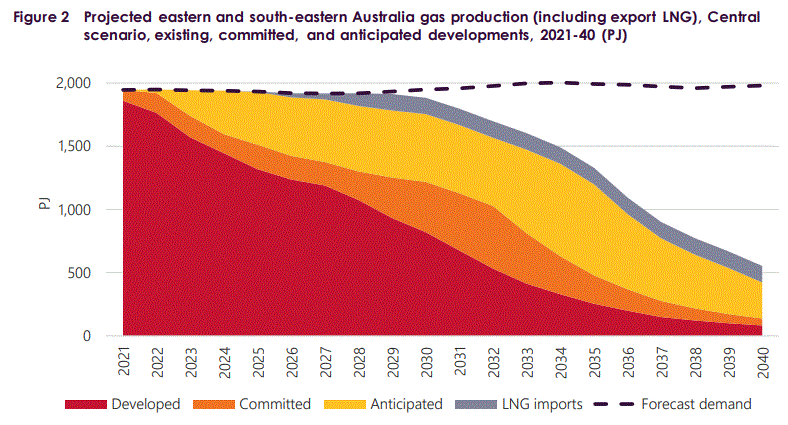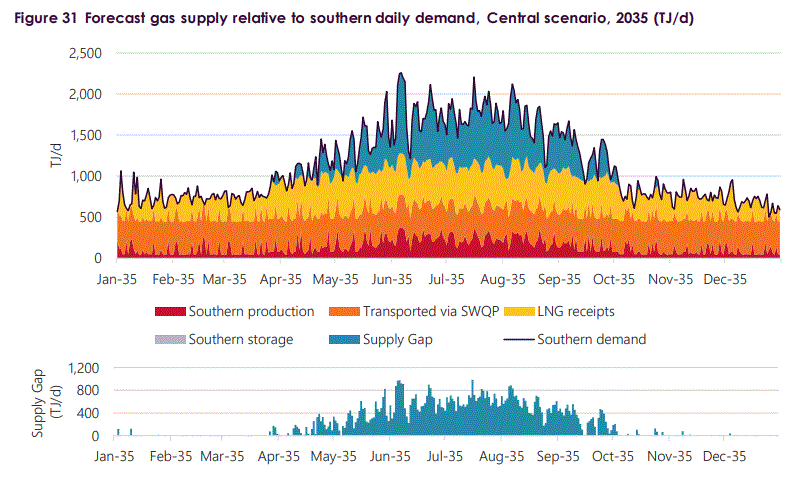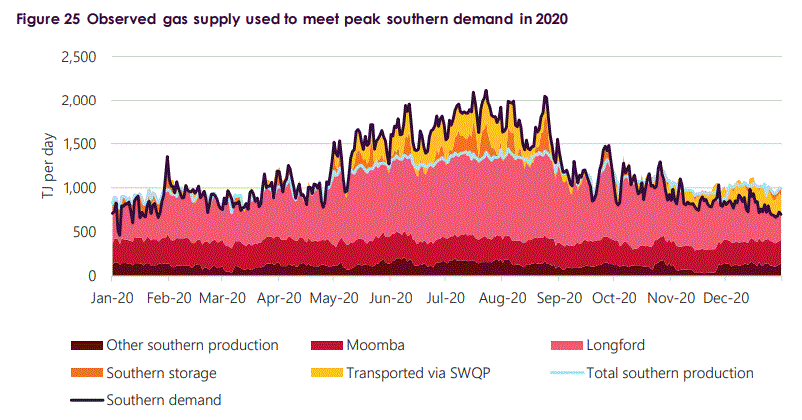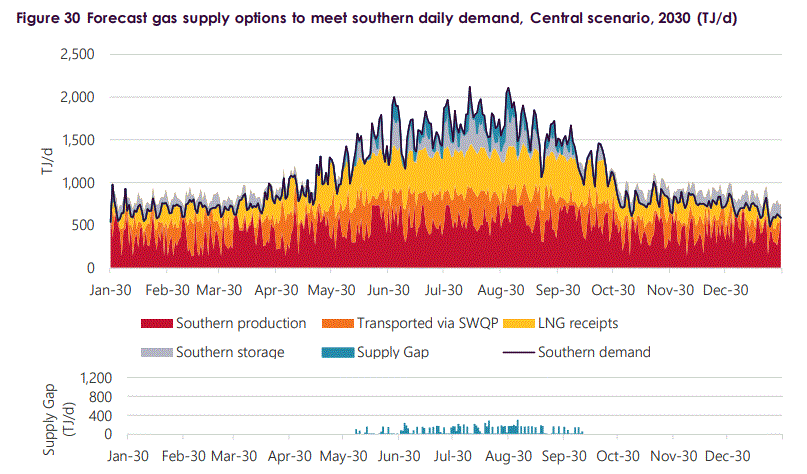Here it is in black and white from the Australian Energy Market Operator:
This GSOO forecasts an improved gas supply outlook compared to last year, largely due to Australian Industrial Energy’s (AIE’s) commitment to the Port Kembla Gas Terminal (PKGT) in New South Wales. This is Australia’s first liquified natural gas (LNG) import terminal, and is estimated to inject up to 500 terajoules (TJ) per day into the domestic market.
• There is now projected to be sufficient supply to address the near-term shortfall forecasts of recent GSOOs (deferring shortfall forecasts to at least 2026), provided the first gas from PKGT is delivered ahead of winter 2023 and other committed field developments and pipeline expansions proceed as planned.
• If PKGT project commissioning is delayed, southern supply scarcity risks have emerged for winter 2023 under certain conditions such as extreme 1-in-20 maximum winter daily demand in Victoria, coincident peaks across southern regions, events in the National Electricity Market (NEM) that increase demand for gas-powered generation of electricity (GPG), or gas production outages.
• These southern supply scarcity risks appear one year earlier than projected last year, due to more rapid decline in producers’ forecasts of maximum daily production from legacy southern fields in Longford, Victoria. The last major southern gas field offering flexible supply is expected to be depleted ahead of winter 2023, reducing gas system resilience.
• Most projects classified as anticipated in last year’s GSOO are now committed, but this GSOO reports fewer new anticipated projects, with limited exploration investment incentivised in the past year, even in northern regions.
• Development of all remaining anticipated projects on schedule, including Golden Beach and new fields in the Gippsland Basin Joint Venture (GBJV), would build resilience to unexpected events. This would help manage operational risks associated with unplanned outages, or project delays in either the gas or electricity system, and defer projected gas supply gaps until the end of this decade.
• Additional demand management initiatives or proposed pipeline expansion could further assist in mitigating supply scarcity risks associated with any potential PKGT commissioning schedule slippage, or LNG cargo delays.This GSOO also highlights that the gas sector in eastern and south-eastern Australia is on the cusp of transformation, with changes in consumption patterns forecast and alternate supply sources being actively developed. It reports on current and projected trends and their implications for system resilience, investment, and the role of gas in the future energy system.
The key transforming trends observed and projected in the gas sector are:
• Industrial demand for natural gas is not forecast to grow in the next 20 years, and could potentially reduce significantly as industrial users in the gas sector start to decarbonise. With an increase in variable renewable energy (VRE), GPG demand may become more ‘peaky’. – Surveyed industrial users indicated their demand is unlikely to increase, even if prices fall. Their current view remains that gas price reductions alone would not drive significant increases in their consumption, but would reduce the risk of industrial closures. The potential impact of sustained lower prices on new manufacturing demand was not modelled.
– By 2040, in a future world where economic production of hydrogen is strong, gas consumption for direct use could decline by as much as 20% (based on scenario assumptions), with an even faster decline then projected to 2050.
– Gas is expected to continue to play a critical role in the electricity sector particular during periods of low VRE generation or prolonged coal-fired generation outages. While the volume of gas consumed for generating electricity is forecast to decline in all scenarios, the value of that generation is expected to increase in line with the growth of VRE and the retirement of coal generation. Over time, daily GPG demand is projected to switch to peaking in winter instead of summer.• There are numerous initiatives underway at both federal and state government level that could change the gas landscape and impact the outlook described here, including the Australian Government’s gas fired recovery plan.
.• The introduction of PKGT and other LNG import terminal proposals currently being progressed have potential to permanently change domestic gas market dynamics.Further investments to address forecast supply gaps should be cognisant of the sector transformation underway and be adaptable to manage future changes in gas consumption patterns. Prudent options could include investments that can:
• Flexibly match supply with seasonal demand and deliver variable annual supply efficiently.
• Manage peak demand needs, potentially through electrification, fuel switching, and energy efficiency.The National Gas Infrastructure Plan (NGIP) being developed by the federal Department of Industry, Science, Energy and Resources (DISER) is considering a number of pathways to unlock gas supply and improve efficiency in the east coast gas market, taking these considerations into account.
The key charts show the shortage only gets worse:

 Of course, none this had to happen. All we needed was domestic reservation of gas and a carbon price to drive alternatives and it would all have been absolutely fine. But that’s Coalition energy policy for ya.
Of course, none this had to happen. All we needed was domestic reservation of gas and a carbon price to drive alternatives and it would all have been absolutely fine. But that’s Coalition energy policy for ya.
Mates first. Everybody else eat price rises.



